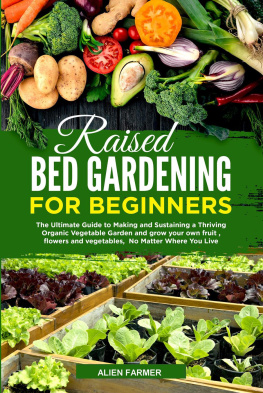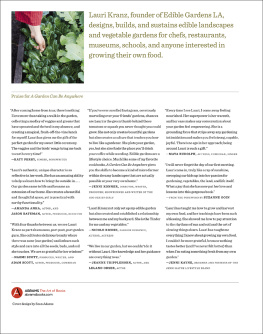THE
edible front yard

THE
edible front yard
Creating Curb Appeal with Fruits, Flowers, Vegetables, and Herbs

by IVETTE SOLER
with photographs by ANN SUMMA

COPYRIGHT 2011 by Ivette Soler. All rights reserved.
PUBLISHED in 2011 by Timber Press, Inc.
PREVIOUS PAGE: A monochromatic hedge of French lavender and globe thistle gives an ornamental backbone to this edible front yard. Photo by Ann Summa
The Haseltine Building
133 S.W. Second Avenue, Suite 450
Portland, Oregon 97204-3527
www.timberpress.com
2 The Quadrant
135 Salusbury Road
London NW6 6RJ
www.timberpress.co.uk
DESIGNED by Cat Grishaver
PRINTED in China
Library of Congress Cataloging-in-Publication Data
Soler, Ivette.
The edible front yard: creating curb appeal with fruits, flowers, vegetables,
and herbs / Ivette Soler; with photographs by Ann Summa. -- 1st ed.
p. cm.
Foreword by Fritz Haeg.
Includes bibliographical references and index.
ISBN 978-1-60469-199-3
1. Edible landscaping. 2. Plants, Edible. 3. Gardens--Design. I. Summa, Ann.
II. Title.
SB475.9.E35S65 2011
635--dc22
A catalog record for this book is also available from the British Library.
table of contents
2 THE NEW FRONT YARD PLANT PALETTE
The Ornamental Edibles
3 EXPANDING OUR EDIBLE PALETTE
The Helpers
6 REALITY CHECK
Assess Your Front Yard
7 OUT WITH THE OLD
Remove and Reuse Lawn, Plants, and Materials
8 BUILDING THE BONES
Hardscape, Privacy, and Irrigation
9 WORKING IT
Organically Maintaining Your Front Yard


Bronze fennel tickles its neighbors: an artichoke and the colorful Sticks on Fire euphorbia. Photo by Ann Summa
foreword
 BY FRITZ HAEG
BY FRITZ HAEG 
Ideas of beauty change with the times, and this book will guide you in the creation of a more evolved and exciting version of front yard beauty that prizes health, diversity, and pleasure over short-term convenience. A lawn is a lawn is a lawn is a lawn, always the same, boring, and conformist, but the garden adventure you are about to embark on is much more fun. These bountiful, dense, diverse, perhaps a bit eccentric, and even slightly wild edible gardens put us back in touch with the land that we live on, the people around us, and the food that we eat. This is a call to arms for you, the front yard gardener, to publicly create your own personal version of the American Dream for the twenty-first century.
The front lawn was the great symbol of the American Dream before we knew better. Connecting home to home from coast to coast, it was originally conceived as a common green. But now it has become clear that this wasteful time-consuming toxic monoculture occupying that critical space between the front door and street is actually an anti-social space, perhaps only occasionally inhabited by someone pushing a loud and polluting two-stroke motor back and forth. The custom of the front lawn has consumed the American landscape with the idea that it was convenient. But just how convenient is a space that takes so much and gives us so little in return? Now that we understand the social and environmental costs of this purely ceremonial space, how can we possibly consider it beautiful?
Are you brave enough to step out your front door and rip up your lawn? Are you creative enough to plan a new garden that will be on view for all of your neighbors to see? Do you know enough to be able to select the right plants and prepare the beds for them to thrive? Are you dedicated enough to do the daily work necessary to publicly grow your own food? This is a down and dirty how-to book, and by picking it up, you have already demonstrated that you are not just interested in reading about this radical act of gardening, but actually doing it. This book will provide you with enough courage, ideas, and information to confidently stride out that front door and get started.
Fritz Haeg is the author of Edible Estates.
 preface
preface 
A front yard revolution is at our fingertips and on our doorsteps. Its time has come. Walking through the ethnically diverse neighborhoods of East Los Angeles, I am always struck by the fascinating and creative ways people utilize their front yards. Some communities are dotted with front yard farms bursting with fruit trees, sugar cane, melons, brassicas, and all manner of greens in well-tended rows, along with pass-along plants from family members. The traditional front yardthe useless, boring, outdated lawn adorned by a few shade trees and perhaps some lackluster shrubberypales in comparison to these vibrant, productive spaces where growing food is serious business. I find these front yard farms inspirational; they speak to a resourcefulness that is long-gone in mainstream American culture, and they have a beauty all their own. Growing edibles out front is also a smart, practical choice: it takes advantage of the simple fact that wherever lawn can thrivein places with significant amounts of sunshineso too can herbs, fruits, and vegetables.
While record numbers of people are growing food and returning to more thoughtful land and resource use, its unlikely that strictly utilitarian front yard farms will be widely seen anytime soon. We still want our front yards to look like gardens. We still want the front of our house to be an inviting and livable spacean extension of ourselves and a reflection of our personal style. The challenge lies in weaving together the pieces to create a front yard that is sustainable, beautifully designed, and edible: a modern-day victory garden. It can be done.
When I purchased my home, I promptly ripped out the front lawn and planted a garden that included such drought-tolerant plants as sages, grasses, and succulents. My blossoming as a cook followed this transformation and I slowly began integrating tough herbs (culinary sages, marjoram, and basils) and architectural edibles, like artichokes and fennel, to associate with the bold agaves that dominate my public garden. Without sacrificing my strong, sculptural planting style, I now have glorious herbs to cook with and vegetables to eat almost all year long. The creation of my successful, interesting, rewarding garden took years, but equipped with the right information, you can have it much faster than I did.
Next page










 BY FRITZ HAEG
BY FRITZ HAEG 
 preface
preface 